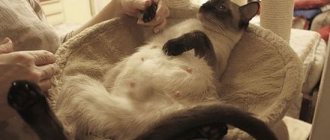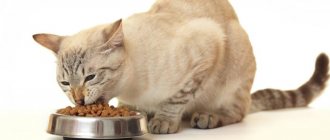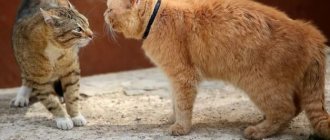Caring for a pregnant cat
The health of the furry offspring largely depends on how its owners will care for the pregnant cat.
First of all, you should pay attention to the diet of the expectant mother. If before conception you fed your kitty dry food, then gradually switch to special food for pregnant animals
They contain much more vitamins that are so necessary for the cat during this period.
Those who are accustomed to feeding their cat from their table, that is, natural food, should consult a veterinarian about taking vitamin and mineral complexes. But you shouldn’t get carried away with them - an excess of certain substances in an animal’s body can do more harm than good and cause the development of various kinds of pathologies in kittens. Not only the menu will have to change, but also the feeding schedule. A pregnant cat should add food to its plate more often, about 5 times a day, but in smaller portions.
It is impossible to carry out anthelmintic prophylaxis and vaccinate cats in this state. These points must be taken care of before mating. As for the fight against external parasites (fleas, ticks, lice eaters), it is not only possible, but also necessary to fight them. The main thing is to use products that do not contain pesticides (for example, stronghold).
Important! If there are small children in the house, warn them that under no circumstances should a cat expecting kittens be lifted by hugging its belly and squeezed in a tight hug!
Kittens move from 6 weeks of pregnancy
Already from 6 weeks of pregnancy you can feel the movement of kittens in the womb. The fetus at this stage is about 5 cm in size. The cat begins to sleep a lot more and its movements become slower. This is when sensory organs such as kittens' ears and noses develop. On the other hand, the nervous system and muscles are not yet developing.
At this point, the cat is experiencing a new change in attitude towards itself. She spends more time looking for a comfortable, warm, soft, dark place. She can search every corner of the house, from the bed to the dresser, to find the perfect spot. You can help her with this task by preparing a basket or cardboard box for her and bringing it back each time. In general, all cats get used to it over time and accept the angle you choose.
In the last days before giving birth, a pregnant cat constantly licks its belly and vulva. Therefore, it is recommended to make room for it and leave it alone while it lasts. It must be said that she can show signs of aggression even towards her owners, meowing and purring under abdominal contractions. At your discretion, you can still check from time to time to make sure everything is in order.
© shutterstock
The birth may depend on both the age of the cat and the number of kittens born. This is usually from 2 to 6. However, it is recommended not to stress her by making room for her and leaving her alone. She will also need peace and rest even after the birth of her cubs.
Planning a cat's pregnancy
If you plan to breed a purebred cat, you should find out in advance whether the resulting offspring will improve the breed (or at least not significantly worsen it). In the case of irresponsible crossing of purebred cats, the appearance of animals becomes more frequent, not only outwardly not meeting breed standards, but also with changes in the skeletal structure that make life difficult for cats, hereditary diseases, and sometimes even a tendency to aggression is transmitted. Find out in advance from your veterinarian what hereditary diseases cats of the same breed as yours are prone to, and conduct the appropriate research to protect future offspring from trouble.
If you decide that the risk justifies the appearance of kittens, and in the case of breeding purebred animals, you find out that your beauty’s family consists of healthy offspring, then to ensure safety, you need to plan everything carefully. For both outbred and purebred cats, there is a danger of contracting some serious infectious diseases during mating. Therefore, veterinarians do not recommend that even outbred animals become pregnant from mating with an “unknown gentleman”; it is better if the male with whom mating is planned has been tested for such infections, has been treated for worms, vaccinated with a complex vaccine and has undergone a general examination by a veterinarian.
Signs of cat pregnancy
The female is ready for procreation most often from the 7th month of life. However, there is no need to rush into mating; the cat’s young body needs to get stronger and mature a little more. The optimal period for the first mating is a year.
Best articles: Guard dogs: varieties and features
The first signs of a cat’s pregnancy appear after 2.5-3 weeks:
- nipples acquire a pinkish tint and swell;
- a noticeable decrease in the pet’s activity;
- morning vomiting is an indicator of hormonal changes;
After 2-3 weeks, the animal regains its appetite. The veterinarian performs palpation on the 20th day. You should not do this yourself because of the high possibility of harming both the future kittens and their mother.
At the 4-5th week of a cat’s pregnancy, weight gain becomes obvious: +1-2 kg. Weight depends on the number of future offspring. The cat becomes more wary of strangers and more affectionate towards her family.
The taste preferences of the expectant mother change, and you may notice mood swings.
After 6 weeks, a large belly becomes noticeable, the animal’s movements slow down, and its gait may change. Starting from the 7th week, the cat is looking for a “nest” and may begin to get nervous. Milk appears in the mammary glands at the beginning of the ninth week.
The birth itself begins with contractions, the whole process takes less than a day, usually 3-4 hours. After contractions and pushing, the fetus will appear in the bladder. The animal gnaws the umbilical cord and may eat the afterbirth. After this, the newborn kitten begins to eat, and the mother continues the birth process.
How to determine the gestational age of a cat
A gradually enlarging belly makes the owner nervous, which can also be felt by the pet.
It’s better to know exactly how far along your cat’s pregnancy is in order to properly prepare for the important event.
The period is determined by the external signs that the cat’s body shows. On days 16-18, the nipples become a bright coral color.
An increased appetite affects the pet’s weight, but you need to make sure that this is a consequence of an interesting situation, and not the presence of parasites in the body. If in doubt, contact a veterinarian and do an ultrasound on the cat during pregnancy, which is determined from the 15th day after fertilization.
If previously the doctor could simply feel a certain number of fetuses in the animal’s stomach, then from the 40th day the veterinarian will tell you the exact number of expected kittens.
It is convenient to use an online calculator, which will calculate the most accurate gestational age for your cat.
What puts a cat at risk of developing pyometra?
A cat's likelihood of developing pyometra increases with age, and affected cats were often in heat for about a month before becoming ill.
Intact females are at greatest risk of developing pyometra, but the condition can also be diagnosed in cats that have been spayed. This is because when a cat is spayed in the traditional way, most of the uterus is removed, but a small part attached to the cervix remains inside the abdomen. This part is called the “stump” of the uterus.
An alternative form of spay removal is becoming increasingly popular, in which the entire uterus remains in the body and only the ovaries are removed. Pyometra is extremely unlikely with either of these two surgical procedures unless the cat is no longer under the influence of reproductive hormones. Unfortunately, this can happen under certain circumstances.
Sometimes ovarian tissue remains inside the cat's abdomen. The tissue may be microscopic and therefore invisible to the surgeon's eye, or a mistake may have been made and a large piece of the ovary remains.
Caring for a pregnant cat:
To feed a pregnant cat, you need to use special food for pregnant women; proper feeding will help future kittens develop well. 3-4 days before birth, it is advisable to do an ultrasound to determine the number and size of the fetuses - this will help predict the course of pregnancy (sometimes the kittens are too large - in this case the issue of surgery is decided).
Top articles: Savarra cat food
Throughout pregnancy, you need to protect the cat from overheating and hypothermia, handle it carefully, and do not allow strong hugs from household members, especially children. If your cat is a fan of climbing to the top of cabinets, then try to limit her jumping to low surfaces to avoid falling.
For the birth and subsequent feeding of kittens, it is necessary to prepare a room - agree with the household that in the room where the cat and kittens will be, there is no need to make noise or perform manipulations that frighten the cat (for example, do not vacuum). To make a “nest” for a cat, you can take an empty cardboard box or use an old bedside table, or make a “plywood maternity hospital” yourself. The large hole for the cat to pass through should be sized to accommodate the fact that a pregnant cat will climb into it; this hole should be located at some distance from the floor so that the kittens, starting to crawl, do not leave the box too early.
Cat pregnancy
Animals have a strong reproductive instinct, but it turns on not just when, but precisely on the most suitable days for conception. Smart nature took care of the continuation of the feline race, so in the life of pets there is a “sexual season”, called the estrus period. A cat can become pregnant about once every three weeks—the body gives the owner’s pet a chance to become a mother.
Few people can resist tiny kittens, especially if they are babies from their favorite cat. The time when the babies begin to run around the house is preceded by a fairly long period of pregnancy and the birth process. An attentive owner must understand all the difficulties of the gestation period, the health of the pet and the nuances of caring for the expectant mother.
How to determine if your pet is ready for mating
Puberty in cats and kittens occurs at 8-9 months. It is at this time that the animal first begins to demand a partner for mating. In some breeds of cats, the first heat may occur much earlier, especially short-haired breeds. It has also been noted that if a cat approaches sexual maturity in winter, then most likely the first heat will be delayed until spring. There are many factors influencing the development of an animal - both internal and external - so there is no need to worry if this happens a little later in your cat.
The behavior of animals changes greatly, so you can easily understand that your pet is “on a spree.” The always affectionate cat becomes aggressive, makes characteristic cries and constantly tries to sneak out into the street. During periods of sexual heat, cats are able to mark territory and imitate sexual intercourse with objects that resemble a cat - soft toys or woolen things. Males do not have specific hunting seasons, like females; they are ready to mate all year round. Excessively active behavior in spring and autumn is associated with a large number of females ready to breed.
Cats, on the contrary, become very affectionate or even apathetic. A cat, ready for mating, constantly takes a characteristic pose - presses its chest to the floor, raises its pelvis and lifts its tail high, while moving its hind legs. She cuddles up to her owner, rubs herself against the table legs, rolls around on the floor, meowing pitifully. The cat also leaves marks containing a pheromone that has a stimulating effect on the cat - valeric acid.
Despite the fact that puberty has already arrived, physiologically cats and female cats are not yet ready to give birth to healthy offspring. The body will be fully formed by about a year. Early pregnancy is fraught with miscarriages, painful childbirth and painful offspring. For cats, mating before full physiological maturity threatens a deterioration in their general health and appearance, can lead to impotence and will definitely not produce strong offspring.
Important! There is also no point in delaying the first mating; it should take place no later than one and a half years.
Ideally, the female skips the first two heats, and on the third one you can calmly look for a groom. Empty heats are fraught with deterioration in health and character due to constant stress; for this reason, it is necessary to sterilize an animal that does not have the ability to reproduce.
It is not recommended for cats to give birth more than twice a year; the age limit for giving birth to offspring is 8 years. A cat needs a cat for mating often - an experienced lover at least twice a month.
Signs of pregnancy in a cat:
The first signs that a cat is pregnant begin to appear approximately 3 weeks after fertilization - increased weight and appetite, increased size and increased pink coloration of the nipples. Until this time, the animal is often the opposite, less active, appetite and activity may be reduced, which often leads owners to false conclusions about a possible disease. Starting from 2-3 weeks, a cat’s pregnancy can be confirmed by ultrasound.
At 4-6 weeks, palpation can already detect the fetus, but it is not advisable to palpate the abdominal cavity of a pregnant cat yourself - careless movements can lead to miscarriage. At the 6th week, a pregnant cat’s rounded belly is already clearly visible. By the 7th week, you can already observe fetal movement, mammary glands enlarge, and sometimes you can observe a small amount of milky discharge from the vagina.
Best articles: TOP 10 largest islands in Russia - map, names, area and brief description
The average duration of a cat's pregnancy is 9 weeks; usually, by the end of this period, cats become less active and calm, and before giving birth, on the contrary, activity increases, the animal begins to actively look for a place for a “birth nest” and ask for affection from the owner. These changes in behavior can begin 3-4 days before birth, but sometimes just before the birth itself, so it is worth being alert for these signs.
How to prepare for the birth of a dog or cat?
Physiology of childbirth in dogs: from A to Z
In this article we will tell you how a normal birth should proceed, when you should and when you shouldn’t worry, in which cases you need to go to the clinic immediately, and when you should just wait.
Do I need to go to the veterinary clinic or call a veterinarian?
Cat giving birth
- This is a normal and natural process. Human intervention should only occur when non-intervention would lead to a problem. Healthy animals give birth on their own and do not require human assistance. This does not mean that childbirth should not be monitored, because childbirth is an unpredictable process, and, unfortunately, sometimes something can go wrong.
False pregnancy in a cat
Usually, after mating, the cat becomes pregnant
The behavior of the pet and some signs confirm the interesting position of the animal: swelling of the mammary glands, caution of the female in behavior, enlargement of the abdomen. But after 3 or 4 weeks all symptoms disappear
This is called a false pregnancy, which is actually a hormonal imbalance in the cat's body. This negatively affects the animal's psyche.
The reasons for the occurrence of false pregnancy lie not only in hormonal imbalance: perhaps the mating was with a sterile cat, or the female’s body has pathologies of the reproductive system, disorders of the thyroid gland.
Treatment includes a diet and a reduction in the amount of dairy products in the pet’s menu, which will have a positive effect on the cat.
It is important to show attention to the injured cat and surround it with care. It is advisable to add vitamins to food
Injections for cats from pregnancy
Not all owners want to get offspring from their pet. To prevent cat pregnancy, special injections have been developed, prescribed according to a regimen selected by the veterinarian.
The injection is given before the onset of estrus, and the effect of the hormonal agent is effective for 6 months. Afterwards, a new dose of the drug will be required.
This is a kind of sterilization, simple to use, and leaving the cat the opportunity to bear offspring after the drug wears off.
This method has disadvantages: dysfunction of the reproductive system, health complications including inflammation and cancer.
Alternative Treatment: Prostaglandin Injections
In the late 1980s, another treatment protocol became available that could spare the reproductive capacity of valuable animals. Here, hormones called prostaglandins are injected to cause the uterus to contract and expel pus. A week of hospitalization is required, and some cramping discomfort often occurs.
This form of treatment is not suitable in cases of closed pyometra because the closed cervix prevents the drainage of infected material even during prostaglandin-induced uterine contractions. Next, the cat needs to be bred for the next sexual cycle. If she is not bred or does not conceive puppies in the next cycle, the recurrence rate of pyometra can be as high as 77%. After recovery from pyometra, the uterus is damaged and can harbor bacterial infection even in normal conditions—pregnancy rates are only 50-65%.
Pros:
- There is a possibility of future pregnancy for the cat (although there is often too much scarring on the uterus).
- Surgery may be avoided in a patient with underlying problems that pose additional anesthetic risks.
Minuses:
- Pyometra may recur.
- The illness goes away more slowly (over a week or so).
- There is a possibility of uterine rupture. This can cause peritonitis and worsen the life-threatening nature of the disease.
- Reproduction must occur during the next sexual cycle.
Pregnancy in cats
Personally, at this stage, fate has rewarded me with two male furry paws, so the happiness of cat motherhood does not threaten me. But this is not a reason not to understand the intricacies of the feline process of pregnancy and reproduction.
Usually, owners of domestic cats sterilize to avoid possible pregnancies, not to bother with the distribution of kittens, and to save the cat from suffering and diseases associated with the feline reproductive system.
But if you are sure that your “valuable fur” has unique characteristics of nature and breed and you really want striped, furry grandchildren, then it is better to approach the issue of cat pregnancy with all responsibility.
What is pyometra?
Pyometra in a cat is defined as a collection of pus in the uterus that can develop due to hormonal, anatomical and physiological changes that occur after a cat has gone through a cycle without becoming pregnant. Bacteria can take advantage of the situation, which can lead to a fatal infection.
The word pyometra comes from the Latin pyo, meaning pus, and metra, meaning uterus. Pyometra is an infected uterus filled with pus. Toxins and bacteria penetrate the uterine wall and into the bloodstream, causing life-threatening toxic effects. The uterus dies, releasing large amounts of pus and dead tissue into the abdominal cavity. Without treatment, death is inevitable. Prevention of this disease is one of the main reasons for sterilizing cats.
In short, hormonal imbalance in the uterus is the cause of pyometra in cats.
With each cycle, the cat's levels of the hormone progesterone increase to prepare the uterus for pregnancy by stimulating the growth of the uterine lining. If pregnancy does not occur, the lining of the uterus will thicken with each cycle until cysts (cystic endometrial hyperplasia) begin to form.
It is these cysts that secrete fluid that allows bacteria to grow and eventually become pyometra. Infection usually occurs two to eight weeks after the last cycle.
Veterinarians also note that white blood cells, which are responsible for fighting infections, often have trouble reaching the uterus during the cycle. This is because white blood cells can damage sperm that may enter the uterus during this critical reproductive period, so the cervix contracts in response.
Drugs containing both progesterone and estrogens, whether synthetic or natural, can also affect the hormone levels in the uterus, which in turn leads to the appearance of pyometra.











